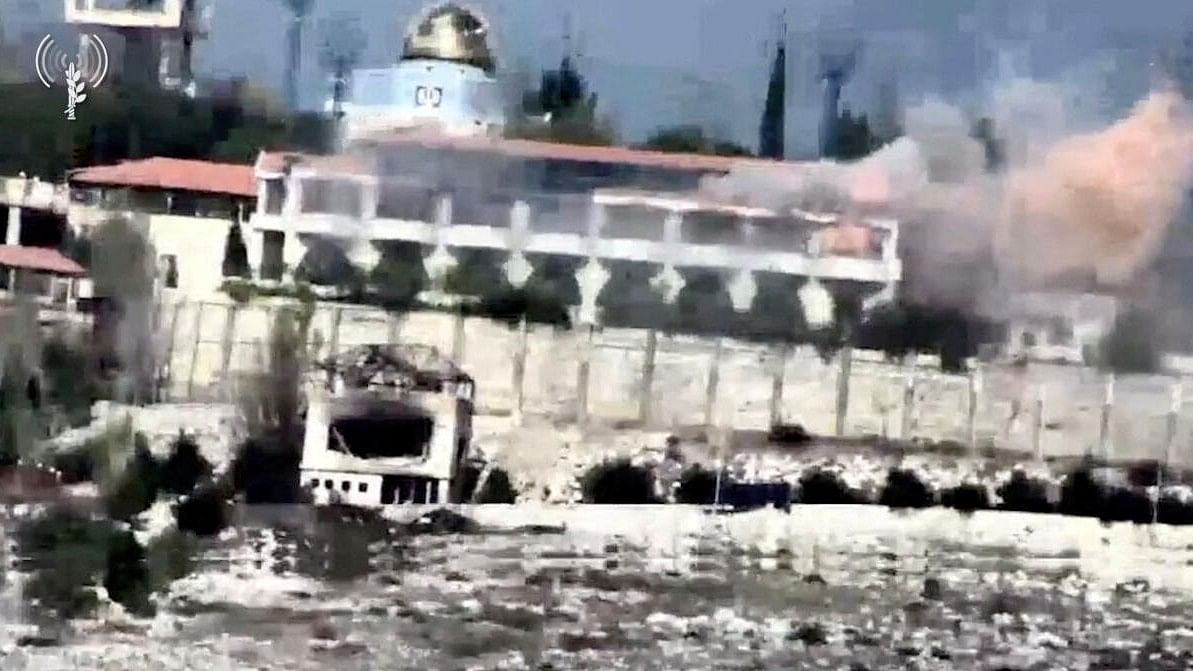
A strike on what Israel military says is a Hezbollah target in a location given as Lebanon is seen in this screengrab.
Credit: Reuters Photo
Hezbollah claimed responsibility Monday for a powerful cross-border rocket attack on an Israeli military base, the latest sign that the Lebanese militia is ramping up their use of newer and more sophisticated weaponry as it attempts to sap the strength of Israeli forces already fighting Hamas.
Although the Israeli military reported no casualties in the attack, footage from the scene verified by The New York Times showed damage to at least six buildings, with one entirely reduced to rubble and burning.
Hezbollah said it had struck the Biranit military base, the headquarters for the Israeli army’s 91st Division, with two Burkan rockets — a powerful improvised munition that the group is increasingly using against Israeli forces. The group’s leader, Hassan Nasrallah, has said the weapons can carry as much as 500 kilograms of explosives.
Video recorded from Lebanon that was released by Hezbollah and verified by the Times shows two munitions apparently hitting the base.
Nasrallah said during a speech earlier this month that his group intended to keep up the pressure on Israel by striking deeper into Israeli territory with newer and more advanced weapons. “There has been a quantitative improvement in terms of the number of operations and the type of weapon used,” Nasrallah said.
Fabian Hinz, a research fellow for the International Institute for Strategic Studies with an expertise in missile proliferation in the Middle East, said that the use of the Burkan, which has a greater explosive payload than other weapons Hezbollah has used, represents an escalation.
“It is a heavier weapon that is being used,” he said. But, he added, using the Burkan — which is short range and can only hit targets immediately across the border — may have less escalatory potential than using “longer-range rockets to conduct strikes deeper into Israel.”
Hezbollah, which exercises de facto control over southern Lebanon, also claimed responsibility Monday for a separate Burkan rocket attack on another Israeli military base, as well as three strikes by exploding drones on Israeli soldiers near Kiryat Shmona, Israel’s northernmost city.
The Israeli military said it had responded to the attacks by hitting Hezbollah operational command centers and infrastructure inside Lebanon. Photographs verified by the Times showed damage to Saint George Church in Yaroun, as well as a collapsed residential building in Khiam. In Mays al-Jabal, the home of a Lebanese lawmaker was also hit by an Israeli strike, according to the country’s state-run news agency.
The strikes were the latest in a series of tit-for-tat exchanges that have grown increasingly severe since Oct. 7, when members of Hamas launched a deadly cross-border assault from the Gaza Strip.
After an Israeli drone strike killed a woman and three girls in southern Lebanon earlier this month, Hezbollah targeted Kiryat Shmona with a barrage of Grad rockets, the first time the group had deployed the weapon since the fighting began. Just over a week later, a group of Israeli electrical workers were struck by an anti-tank missile while working along the border, killing one person and injuring several others.
And on Saturday, Hezbollah claimed to have used a surface-to-air missile to down an Israeli Hermes 450 drone. The Israeli military said that a drone had been forced to make an “emergency landing” in northern Israel, and that it had responded by striking what it called an “advanced” surface-to-air missile system.
Video released by the Israeli military of the strike, and located by the Times, shows that it was carried out some 10 miles away from the border — further into Lebanon than much of the fighting so far.
“The Burkan is something new. Surface-to-air missiles are something new. The suicide drones are new,” said Elias Hanna, a military analyst and former general in the Lebanese military. “They are using them to send a message — we have the firepower, and we have the will to use it.”